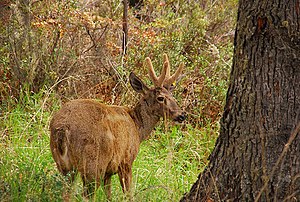Southern Andean Deer
| Southern Andean Deer | ||||||||||||
|---|---|---|---|---|---|---|---|---|---|---|---|---|

Southern Andean Deer ( Hippocamelus bisulcus ) |
||||||||||||
| Systematics | ||||||||||||
|
||||||||||||
| Scientific name | ||||||||||||
| Hippocamelus bisulcus | ||||||||||||
| ( Molina , 1782) |
The South Andean deer ( Hippocamelus bisulcus ), also called Chilean Huemul or Guemal , South Andean Huemul or Patagonian Huemul , is a medium-sized species from the deer family that is native to the Andes of southern Chile and Argentina . Huemuls reach a shoulder height of 90 centimeters and a weight of 90 kilograms. The IUCN has classified the species as critically endangered. The South Andean deer is closely related to the somewhat smaller North Andean deer .
description
As a medium-sized species of deer with short, chamois-like legs and a plump body, the Huemul is well adapted to life in the high mountain regions of the Andes. The shoulder height is 80 to 90 centimeters, the head-trunk length 140 to 175 centimeters. The tail is on average 13 centimeters long. The upper line of the base of the neck is clearly concave, the forehead broad and the ears long and pointed and resemble those of the donkey . The very dense fur is dull brown. The winter coat has a greyish tone. Males have a dark stripe on the bridge of the nose that forks between the eyes, giving the impression of a pair of dark eyebrows.
The dichotomous antlers , which only the males wear, stand on clearly raised rose bushes and usually only develop to a forked state, but occasionally develop irregular ends. The rod forms a long skewer and is weak near the Rosenkräuselung fluted and a little bubbled.
habitat
The Chilean Huemul is found nowadays mainly in the mountains of the Andes, from sea level to heights of 3000 meters. Preferred habitats are the forest edges and forests of the beech trees . The Huemul still inhabits different habitats locally: from valleys to steep mountain slopes, from open grasslands to closed bush landscapes or wooded habitats, including mixed habitats or even forest fire areas . The patterns in which the different habitats are used vary and depend on their availability, the time of year, the occurrence of other herbivores and predators, and human disturbance. In the past, however, the Huemul also occurred in the completely tree-free areas of the Patagonian grass plains.
The highest remaining population density is found in coastal periglacial glacial valleys that are at sea level. Because of their remoteness and harsh environmental conditions, these areas have received less human exposure than elsewhere.
The size of the grazing areas used over the year is estimated at 350 to 650 hectares , whereby daily distances can be up to 8 kilometers, but rarely exceed five kilometers.
Behavior and ecology
Huemuls come together in groups of up to eleven individuals. Single males are also not uncommon. In the past, however, the group size could be more than 100 Huemul, but this was very likely to be winter gatherings. This leads to the conclusion that the population density was higher than today in many places. There are many solitary males. Males gather several females around them and aggressively defend them against other males.
On the one hand, southern Andean deer are not very picky about their food, which largely depends on the vegetation community of the respective habitat and the competition from other herbivores. On the other hand, female specimens spend 93% of their foraging just to eat two different types of plants. The composition of the food differs from subpopulation to subpopulation, sometimes considerably. As a leaf eater, however, the Huemul mainly needs buds, twigs and other woody plants for food. The high nutrient requirements of ruminants includes dry grasses because of poor digestibility than food source. However, depending on the season, Huemul also consume freshly grown grass. There are indications of seasonal hikes, which can vary in length and duration depending on the habitat, food availability and snow cover.
The rut takes place mainly from mid-February to mid-April, sometimes until the first week of June, during which time the males court the females. The males sniff the females vigorously, pleading and following them, touching them and finally mating. The females initially evade in a zigzag, and the males seldom try to prevent one female from approaching another male. Every 10 to 12 days, courtship behavior in front of the same female peaks in connection with follicular maturation . Rivals are attacked, but threats and imposing are few and far between and ritual fights are also rare. The males set scent marks by rubbing their face and head on the vegetation. Most boys are born in November and December. The fawns are not spotted and usually lie hidden in safe places while the mother looks for food.
Natural enemies of the Huemul are the puma and the Andean jackal , whereby the jackals are particularly dangerous to the young. Humans and domestic dogs pose further serious threats to deer. In contrast to European deer, southern Andean deer are not very shy of humans, which has contributed to their easy huntability. Densely populated regions, especially regions with numerous domestic dogs that have run wild, are avoided. When southern Andean deer feel threatened by predators , they first try to avoid the danger by standing still or hiding, which, however, is not an ideal strategy in view of the hunting by humans with firearms. On the run, they try to shake off stubborn pursuers with their speed or by taking refuge in rock walls or in lakes, as they are very efficient swimmers. According to observations, adult Huemuls tire after relatively short distances.
Spread and endangerment
The southern Andean deer is endemic to mountainous regions of southern Chile and southern Argentina. Estimates of the population of the southern Andean deer range from 1048 to a maximum of 1500 animals. This corresponds to a decrease of 99% compared to the original inventory. Due to the fact that the southern Andean deer mainly prefers remote and inaccessible, wooded and rugged terrain, precise estimates of the population sizes are difficult. The population density is 5–8 individuals per square kilometer. The population is strongly fragmented over the entire distribution area and is divided into 101 groups (subpopulations).
The type was originally widespread south latitude and 54 degrees 34 between while today only very narrow within one, about 1900 km long strip between the 40th and the 49th latitude is found, with a population reliktären between the 36th and 37th parallel. This suggests that the range has shrunk dramatically since the 19th century, so that the populations are now very small and fragmented. It is estimated that populations of the species have decreased by 50% in Chile and by a third in Argentina over the past few decades. However, a stabilization of individual populations could be determined as soon as effective protective measures such as the removal of livestock from the protected areas and the strict prosecution of poaching are implemented. In the valleys examined, an increase in population size could even be observed between 2004 and 2008, which is based on the immigration of Huemul from higher altitudes. However, other studies conclude that South Andean deer populations are in a distinct process of decline and genetic impoverishment.
The southern Andean deer is considered to be critically endangered and, like the closely related northern Andean deer, is listed in Appendix I of the CITES Agreement. The IUCN lists the southern Andean deer as endangered . The most important reason for the decline in populations and the range of distribution is probably a combination of excessive hunting, excessive livestock and the conversion of natural areas into agricultural areas, which results in loss of habitat, especially in wintering areas, and the associated decrease in winter migration. Huemuls cannot survive in areas with a snowpack higher than 30 centimeters. Further threats are the competition for food from other herbivores, in particular the introduced red deer , the small size of the subpopulations themselves and the associated genetic impoverishment and the vulnerability of the small populations to diseases and predators. In addition, the responsible governments continue to take inadequate protective measures .
The displacement process began even before the arrival of the Spaniards and reached its peak before reliable, systematic studies of the stocks were undertaken. Analogous to the settlement history, the effects were initially greater in the north than in the south, especially in the north-western central valley of Chile.
The distribution areas of the southern Andean deer and the closely related northern Andean deer do not overlap.
Protective measures
63% of all subpopulations are outside of protected areas and there is an urgent need for a management plan to preserve the last specimens. The humuel is on the red list in both Argentina and Chile . The species has been protected in Chile since 1929 and in parts of Argentina since 1989. Most of the protected areas in both countries exist only on paper: Financial restrictions lead to insufficient staffing and infrastructure and thus prevent precise recording and monitoring, the prerequisite for the implementation of effective protective measures.
As part of the Bonn Convention , Chile and Argentina signed a declaration of intent in 2010 for the more effective protection of the South Andean deer, which is acutely threatened with extinction. In the paper, both sides agree to work together to develop effective protective measures for the subpopulations with cross-border habitats, and to identify and conserve those habitats within the range of the Huemul that are of vital importance for the survival of the species. Furthermore, the signatory states intend to take appropriate measures to regulate and control factors that have a detrimental effect on conservation measures (i.e. action against poachers , loss of habitat, introduction of diseases, etc.).
In addition, the contracting parties strive for a scientific exchange with regular status reports and annual meetings as well as the implementation of an action plan.
Others
The Huemul is depicted on the Chilean national coat of arms together with an Andean condor . Both animals wear a crown. The southern Andean deer and the condor are national symbols of Chile.
Individual evidence
- ↑ a b c d e f g h i j k Jiménez, J., Guineo, G., Corti, P, Smith, JA, Flueck, W., Vila, A., Gizejewski, Z., Gill, R., McShea, B. & Geist, V. 2008: Hippocamelus bisulcus . In: IUCN 2012. IUCN Red List of Threatened Species. Version 2012.2. <www.iucnredlist.org>. Downloaded on June 04, 2013.
- ↑ Hans Krieg (1925): Biological travel studies in South America. In: Zeitschrift für Morphologie und Ökologie der Tier , Vol. 4, pp. 585–597.
- ↑ a b c Barberena, R., C. Méndez, F. Mena y O. Reyes (2011): Endangered species, archeology, and stable isotopes: Huemul (Hippocamelus bisulcus) isotopic ecology in Central-western Patagonia (South America). In: Journal of Archaeological Science 38, pp. 2313-223.
- ↑ a b c Briceño, Cristóbal et al. (2013): Detecting an increase in an Endangered huemul Hippocamelus bisulcus population following removal of cattle and cessation of poaching in coastal Patagonia, Chile. In: Oryx , Volume 47, Issue 02 (April 2013), pp. 273-279
- ↑ Povilitis, A. (1985): Social Behavior of the Huemul (Hippocamelus bisulcus) during the Breeding Season. In: Zeitschrift für Tierpsychologie , Vol. 68, Issue 4 (December 1985), pp. 261-286.
- ↑ Vila, Alejandro et al. (2009): Feeding Ecology of the Endangered Huemul ( Hippocamelus bisulcus ) in Los Alerces National Park, Argentina. In: Mastozoología Neotropical , 16 (2), pp. 423-431
- ↑ Text of the "Memorandum of Understanding between the Argentine Republic and the Republic of Chile on the Conservation of the South Andean Huemul" (English; PDF; 31 kB)


